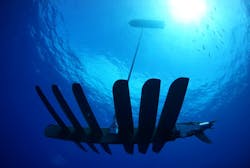SAN DIEGO – U.S. Navy researchers needed long-endurance unmanned surface vessels (USVs) and sensor payloads for ocean persistent surveillance in classified and unclassified missions. They found their solution from Liquid Robotics Inc., a Boeing company in Sunnyvale, Calif.
Officials of the Naval Information Warfare Center-Pacific in San Diego announced their intention last month to award sole-source purchase orders to Liquid Robotics to buy the company's Wave Glider USVs, which for military applications are branded as the Sensor Hosting Autonomous Remote Craft (SHARC).
These USVs will have mission-specific sensors and payloads to demonstrate mission capability. Liquid Robotics will provide prototype systems, spares, maintenance, software licensing, and engineering support for missions in the maritime environment.
The value of upcoming contracts will be about $12.5 million. The exact value has yet to be negotiated.
The Liquid Robotics Wave Glider is an autonomous unmanned surface vessel powered by wave and solar energy. It has two components -- a surface vehicle about the size of a surf board, and a tethered submersible with moving wings that dangles underneath the surface vessel to harvest wave energy for forward propulsion. It can travel as fast as 3 knots.
The Wave Glider USV can operate individually or in fleets to deliver real-time data and act as a data communications relay for as long as one year with no fuel.
Wave Glider instruments, working together, can provide fleets of networked wave-powered ocean robots for military, oil and gas, commercial, and science applications.
Key to the Wave Glider is its ability to harvest energy from ocean waves to provide essentially limitless propulsion to provide persistent surveillance at sea. Wave Gliders run on wave and solar energy for propulsion, communications, navigation, and computing.
story continues below
Wave Gliders operate at the surface of the ocean and can travel across great expanses for a year at a time without returning to port. They can monitor coastlines and connect the subsea world to shore, air, and space. They can survive and operate through some of the ocean's most severe conditions, such as hurricanes.
The Wave Glider harvests power from the up-and-down motion of the waves by converting this energy into forward thrust. The Wave Glider is equipped with computers for navigation, communications, and ocean sensors.
Wave Glider sensors can measure weather, sea conditions, water quality and chemistry, bottom topography, and currents. Acoustic microphones and arrays enable real time communications from subsea to space and can detect passing ships and capture vocalizations of whales and monitor other mammals.
Military applications of the Wave Glider and SHARC include anti-submarine warfare (ASW), countermine operations, coastal and border security, drug and human trafficking interdiction, and maritime domain awareness.
Related: Logos to provide airborne persistent-surveillance sensors in $111.8 million Navy contract
Users can operate the Wave Glider autonomously or control the USV virtually via any secure Internet connected device. The system can store data onboard or transmit it in real time via satellite or by cellular phone networks depending on the distance to shore.
The Wave Glider's software operating environment is called Regulus, and is based on Linux and Java. The system uses the Liquid Robotics Adaptable, Modular Power System (AMPS) to provide scalable power to support the most power hungry sensors. The onboard battery storage scales from 0.9 to 4.5 kilowatt hours.
The Wave Glider and SHARC vessels have low observability and detectability. It cannot be detected by radar or infrared sensors, and is acoustically silent. Wave Glider can carry or tow a range of sensors, including acoustic Doppler current profiler (ADCP) sensors, weather stations, fluorometers, hydrophones,, cameras, and water quality-sensors.
For more information contact Liquid Robotics online at www.liquid-robotics.com, or the Naval Information Warfare Center-Pacific at www.public.navy.mil/navwar/NIWC-Pacific/Pages/default.aspx.



